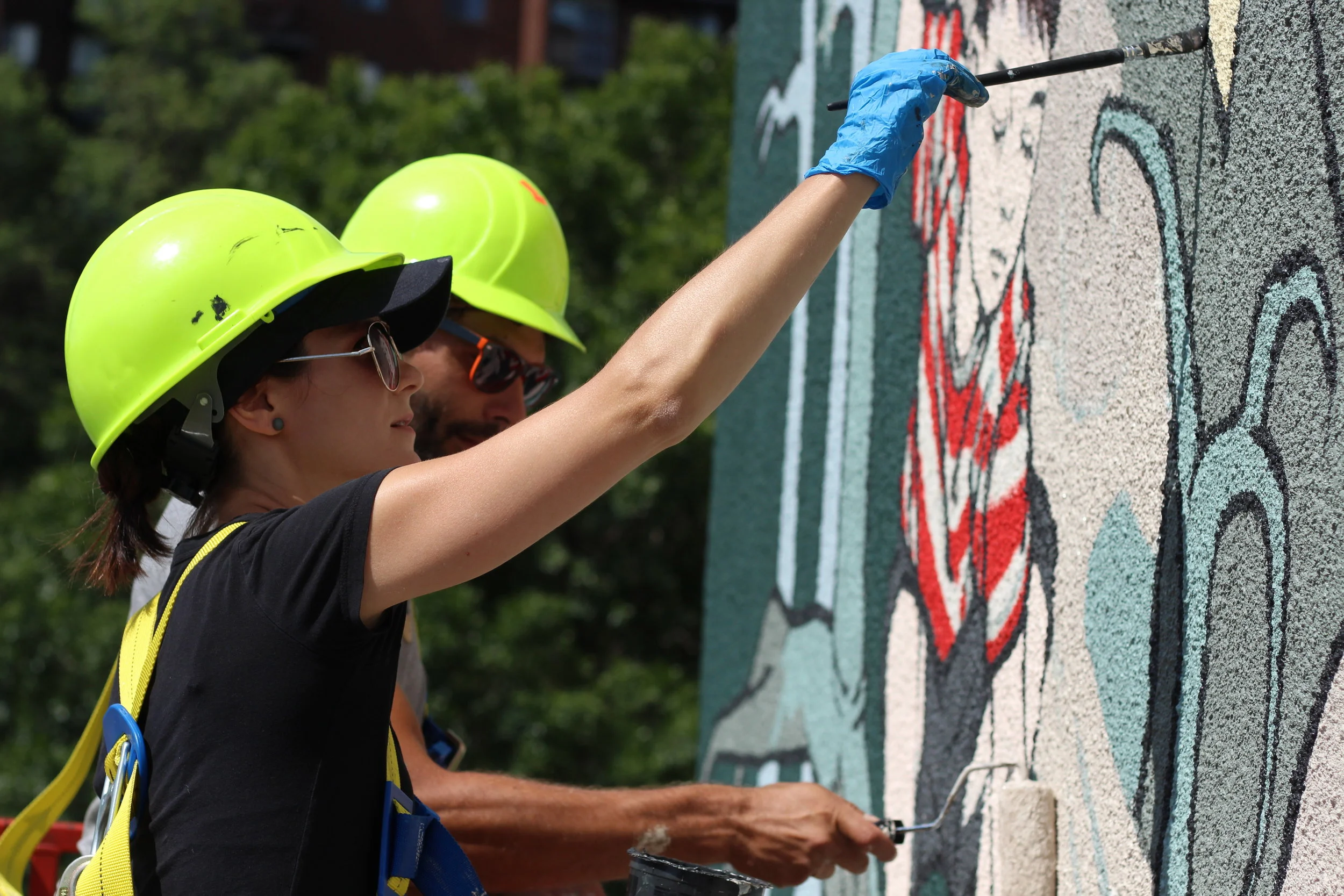Interview with an Up Here Muralist: Laura Peturson
Photo by Bennett Malcolmson
Laura Peturson is one of Up Here 5’s (practically) local muralists. She’s based in Callander, Ontario and teaches printmaking, painting, and drawing at Nipissing University. Her mural is at the corner of Ste Anne Rd. and Notre Dame Avenue. I was able to sit down with her and talk to her about her artistic practice and work at Up Here 5. It was also a chance for me to nerd out a bit with Peturson about 19th and 20th century painters and print makers—both influences in her style.
Here are some moments from our time speaking together that offer some insight into her mural and her thought process in approaching this project.
Can we start by having you describe your artistic practice for those who are being introduced to work for the first time?
I work mostly in relief printmaking—doing woodcut, linocut, and paper cut.
So, I am primarily a print maker but I have done a lot of interior murals in gallery spaces that are an installation-based practice where I carve large wood and lino-blocks in combination with painting, paper-cut, and repurposed existing prints to create an immersive space in the gallery.
I tend to have an illustrative and narrative style, using images from childhood and children’s literature.
Can you explain some of the narrative elements of your mural or some of the ideas you were working with?
When we’re young our physical place plays an important role in the formation of our identity and our sense of inner self. There’s an archetype of “an explorer in the wild” that comes up again and again in kids’ lit, and part of that is because of this time of being unencumbered by adult intervention. My kids live in the North and there’s a lot of time where they develop conspiratorial, imaginative, and elaborate games in relationship to the place that is directly around them.
A lot of the drawings I made in preparing for this are of sights around the place where I live where a tornado passed and it uprooted all these trees. It was devastating at first because it changed the landscape but then it also created these new natural place-bases. It is an interesting amalgamation of memory and the altered-state of the environment around where we live.
With my own kids, there’s this sense of being on the edge of safety.
Have children always been an element in your work? Or did it change when you had children?
Always, but the perspective changed. It was stuff to do with my own sense of identity, memory, and place. Then it really changed being with kids all the time—I’m a really dedicated sketchbook keeper and always have it on me, so I draw and observe them all the time. Kids are really complex and fascinating. I feel they trigger a lot of ideas or things that I didn’t remember that I remembered. As a kid, everything’s an experiment and it’s all intense.
We tend to see narrative and illustrative styles on the smaller scale, how did you approach such a large space for your work?
Yes, something like narrative illustration tends to be very human size and usually comes in book size, working on paper, so trying to create a bigger sense space with a different scale for the figures was different. Normally figures take up a large portion of the composition in my work and the emphasis is on them. Working at this scale, the balance is flipped. The space around the figures becomes more emphasized.
I thought about it a lot from a design perspective. When I was developing the composition I was thinking about how your eye goes to the area of greatest contrast—so having a high value contrast for the figure on the upper left (because he is dwarfed by this big root-ball) and I wanted that to be a focal point. But also having secondary and tertiary areas of interest, if you had the time to move between them. But I also used diagonals and allowed for quieter space. Allowing space for the tree to be in composition (casting a shadow and overlapping the wall).
When I do paint it is usually not in this style. There are linear elements similar to print making, but this is not the way I would paint on a small scale.
I noticed that John Singer-Sargent has come up as an influence of yours. When I learned about Singer-Sargent I got the impression that he wasn’t that cool.
No, not cool at all.
What makes him cool to you?
I could talk to you for an hour about John Singer-Sargent. I love a lot of 19th Century painting. I feel like it’s an interesting time in the way people were looking at children. The idea of childhood and adolescents being things separate from adulthood was interesting. But also he is effortless in terms of his technique. Some of the paintings look abstract up close. I like the depiction of domesticity. He does a lot of portraiture and has amazing images of children and I think that the idea of one’s place in a family is an interesting idea that you see in his work (as well as Mary Cassatt’s work, William Merritt-Chase). Mary Cassatt did a lot of beautiful etchings that have an interesting tension between high-realism and and really flat and abstract space. I look at the design and technical aspect of that time period.
What artists do you like?
I really like Alex Colville and Mary Pratt.
Alex Colville—there’s a sense of ambiguity, mystery, and atmosphere. These are elements that I’m aiming for in my work. There are a lot of shapes and visual elements that are ambiguous in my work. I like open-endedness so there is some direction and clarity, but there is still a tension with mystery and I’m leaving the viewer with the space to decipher the image and put themselves into the work.
Thanks so much. I’ll leave by asking how its been working in a public space and creating this mural for Up Here?
It’s been so fun. We have a group of kids living in this complex and now I know their names and they’re checking in on us and the progress—so, I’ve gotten to know people just in this building. Lots of people are coming by and are interested in what is happening—it’s been great.
Photo by Bennett Malcolmson


